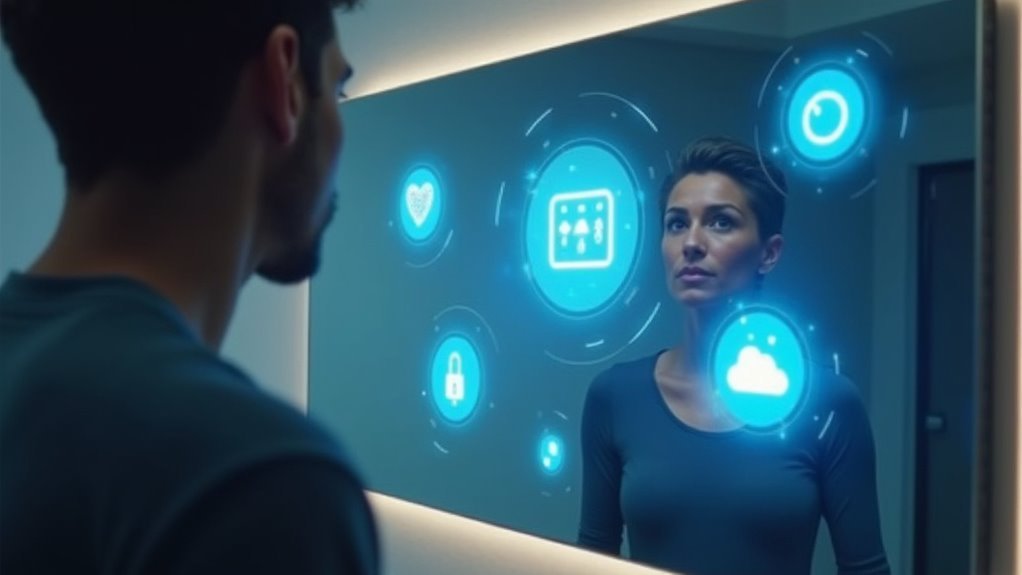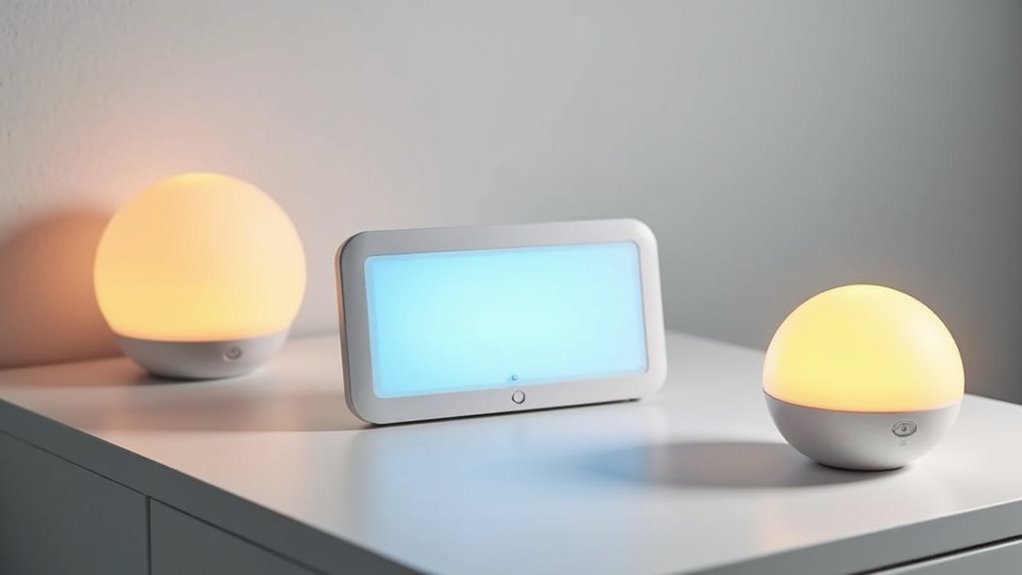You’ve likely encountered situations where you needed better visibility around blind corners or wanted automated alerts when someone approaches your property. A mirror notification system combines traditional convex mirrors with modern sensor technology to create an intelligent monitoring solution that actively communicates with you and other connected devices. This hybrid approach transforms passive safety equipment into a dynamic network that can detect movement, trigger alerts, and even integrate with your existing security infrastructure, but there’s more to contemplate before implementing one.
Understanding Mirror Notification Technology

When you implement a mirror notification system, you’re fundamentally creating a communication network that allows different modules to talk to each other through event-driven messages.
These notifications serve as signals that trigger specific behaviors, such as showing or hiding modules when you press certain buttons. Your system becomes more dynamic and interactive through this event-based architecture.
However, you’ll notice that not every module participates equally in this mirror notification system. Some modules only broadcast messages, while others exclusively listen for notifications.
This asymmetrical communication pattern means you need to understand which notifications are available since there’s no centralized management system. You’ll configure specific methods in your setup files to define how modules respond to user actions and system events.
Core Components and Hardware Requirements
Before assembling your mirror notification system, you’ll need to understand the essential hardware components that make it function effectively.
These systems eliminate dangerous blind spots through integrated technology that works seamlessly together.
The core components include:
Essential hardware components work together seamlessly to create an effective mirror notification system that eliminates dangerous intersection blind spots.
- Dome mirror – Provides wide-angle visibility to reduce blind spots at intersections
- Strobe light and audible alarm – Delivers visual and audio warnings with 28 different tone options
- Microwave motion sensors – Detects vehicles up to 80 feet away with 100ms response time
- Power supply system – Requires hard wire connection operating on 120 VAC and 15 amps
You can customize your installation with 1 to 4 sensors depending on your specific intersection requirements, ensuring ideal traffic safety management for your facility’s unique layout and traffic patterns.
Types of Notification Systems Available

Three distinct categories of mirror notification systems offer varying levels of safety enhancement for your intersection management needs.
Visual-only systems provide amber warning lights in your side mirrors that illuminate when sensors detect vehicles in adjacent lanes. These Blind Spot Detection indicators offer silent alerts during lane changes and passing maneuvers.
Audio-enhanced systems combine visual warnings with audible alerts, featuring multiple tones to cut through noisy environments. You’ll receive both mirror lights and sound notifications when vehicles enter your blind zones.
Comprehensive systems integrate Lane Change Alerts and Side Blind Zone Alerts with both visual and auditory components.
These advanced configurations use radar sensors to monitor surrounding traffic continuously, ensuring you’re warned of potential hazards regardless of environmental conditions that might affect sensor performance or visibility.
Sensor Detection Capabilities and Range
Mirror notification systems rely on sophisticated sensor technology to deliver accurate vehicle detection across specific operational ranges.
You’ll find these systems equipped with microwave motion sensors that can detect vehicles up to 80 feet away, providing ample warning time for personnel safety.
The sensor detection capabilities include several key features:
- Rapid response time of 100 milliseconds for immediate notifications
- Customizable sensor configuration with 1 to 4 sensors based on your intersection needs
- All-weather operation maintaining effectiveness across various ambient conditions
- Optimized coverage for high-traffic areas like intersections and blind corners
You can rely on these sensors to enhance safety for both pedestrians and forklift operators, particularly in environments where visibility is compromised and timely alerts are critical.
Visual and Audio Alert Mechanisms

When vehicles approach within the sensor’s detection range, the Traffic Alert Mirror System activates multiple warning mechanisms to guarantee maximum safety awareness.
You’ll immediately notice the bright strobe light illuminating the area, providing essential visual notification that eliminates dangerous blind spot situations. The system’s audible alarm offers 28 different tones, making sure you can customize alerts based on your facility’s specific requirements and ambient noise levels.
These dual alert mechanisms work together to create thorough safety coverage. The flashing lights prove especially valuable in noisy industrial environments where audio warnings might get drowned out.
Meanwhile, the varied audible tones penetrate through equipment noise and conversations. This combination assures that whether you’re walking, operating machinery, or focused on tasks, you’ll receive clear warnings about approaching vehicles, greatly reducing accident risks at intersections.
Installation Process and Setup Requirements
You’ll need to meet specific hardware installation requirements before setting up your traffic alert mirror system at intersections or high-traffic areas.
The system requires a hard wire connection operating on 120 VAV / 15 amps to power the sensors and alarms reliably.
Once you’ve secured the proper electrical connection, you can configure the system with 1 to 4 sensors based on your facility’s layout and traffic patterns.
Hardware Installation Requirements
Before installing your Traffic Alert Mirror System, verify you have access to a dedicated 120 VAV / 15 amp electrical circuit at the mounting location.
These hardware installation requirements guarantee your system operates reliably and safely.
Your installation checklist includes:
- Electrical connection – Hard wire the system to a 120 VAV / 15 amp circuit for consistent power supply
- Mounting chain – Purchase separately to secure the mirror system at your chosen location
- Sensor configuration – Select 1 to 4 sensors based on your intersection’s specific coverage needs
- Strategic placement – Position microwave sensors within 80 feet of detection zones for maximum effectiveness
Focus on busy facility intersections, pedestrian crossings, and high-traffic areas where enhanced visibility protects workers most effectively.
Proper hardware installation requirements compliance assures peak system performance.
System Configuration Steps
After completing your hardware installation requirements, configure your Traffic Alert Mirror System through a systematic setup process that integrates all safety components. You’ll need to establish the 120 VAV / 15 amp hard wire connection first, then synchronize the dome mirror, strobe light, and audible alarm components.
| Configuration Step | Component | Action Required |
|---|---|---|
| Power Setup | Electrical Connection | Connect 120 VAV / 15 amp wiring |
| Sensor Calibration | 1-4 Sensors | Adjust detection zones per intersection needs |
| Component Integration | Mirror/Strobe/Alarm | Synchronize all safety features |
Position your side view mirrors for maximum visibility at pedestrian crossings and high-traffic intersections. Test each sensor’s detection range and verify the strobe light and audible alarm activate properly when motion’s detected. Remember to secure mounting chains separately since they’re not included in the package.
Configuration Options and Customization
When implementing the Traffic Alert Mirror System, you can configure it with one to four sensors based on your intersection’s specific safety requirements. These configuration options deliver remarkable flexibility for various workplace environments.
The system’s customization capabilities include:
Tailor your Traffic Alert Mirror System with multi-sensor configurations, flexible mounting options, and customizable audio alerts for optimal safety coverage.
- Multi-sensor setup – Choose between 1-4 sensors to match your intersection’s complexity
- Versatile installation locations – Perfect for busy facility intersections, pedestrian crossings, and high-traffic areas
- Flexible mounting solutions – Optional chain mounts provide adaptable setup configurations
- Customizable audio alerts – Select from 28 different alarm tones to suit ambient noise levels
You’ll appreciate the self-contained design that integrates a dome mirror, strobe light, and audible alarm into one all-encompassing unit.
This guarantees maximum visibility and alerting capabilities while simplifying installation across different facility layouts.
Module Integration and Communication
You’ll need to establish communication pathways between modules since mirror systems like MagicMirror don’t provide centralized management for module interactions.
Broadcasting notifications through defined methods and controlling module visibility with commands like MM.hide() and MM.show() forms the foundation of inter-module communication.
Setting up custom notification handlers guarantees your modules can respond to specific events and coordinate their behavior effectively.
Notification Broadcasting Methods
Once you understand the basic notification structure, broadcasting methods become the backbone of module communication in your mirror system.
These notification broadcasting methods facilitate seamless interaction between different components, allowing modules to signal events and respond dynamically to user input.
You’ll primarily use these core broadcasting techniques:
- MM.hide() and MM.show() – Control module visibility based on received notifications
- Configuration file methods – Send notifications directly through your config settings for automated responses
- Custom module modifications – Adapt modules like MMM-Buttons and MMM-ProfileSwitcher to interpret specific broadcasts properly
- Console monitoring – Track notification flow to debug communication issues and verify proper integration
These methods guarantee your modules work together cohesively, creating a responsive and interactive mirror experience.
Module Visibility Control
Three fundamental visibility commands form the core of module display management in your mirror system. Module visibility control relies on MM.hide() and MM.show() methods to dynamically manage which modules appear on your display. You’ll trigger these commands through notifications that signal events between different modules based on user interactions.
| Command | Function | Usage |
|---|---|---|
| MM.hide() | Conceals module | Button press events |
| MM.show() | Displays module | Profile switching |
| MM.toggle() | Alternates state | Cycling actions |
However, not all modules handle notifications uniformly. Some only broadcast specific commands while others exclusively listen for particular signals. You’ll need custom modifications to guarantee modules like MMM-Buttons and MMM-ProfileSwitcher communicate effectively. Monitor notifications through Electron’s console to debug and verify that your visibility commands work correctly across your integrated system.
Custom Communication Setup
Effective module communication requires establishing specific notification pathways between components that weren’t originally designed to work together.
You’ll need to modify modules like MMM-Buttons and MMM-ProfileSwitcher to understand each other’s custom notifications, such as implementing a “CYCLE_PROFILE” notification. This creates seamless interactions between your side mirror’s interface elements.
Setting up custom communication involves:
- Modifying module configuration files to define specific notification methods for targeted interactions
- Implementing custom notification handlers that respond to broadcasts from other modules appropriately
- Testing notification pathways by monitoring console output to verify messages are transmitted and received correctly
- Creating fallback mechanisms to guarantee your system remains functional when communication fails
Track notifications through your console to debug integration issues and confirm your modules communicate effectively.
Safety Applications in Different Environments
When you’re managing operations across diverse industrial environments, the Traffic Alert Mirror System adapts to meet specific safety challenges in each setting.
In warehouse loading docks, you’ll find it invaluable for preventing forklift collisions where visibility is severely compromised by stacked inventory and structural obstacles. The system’s 80-foot detection range gives operators ample warning time before entering dangerous zones.
At manufacturing facilities, the Traffic Alert system excels in high-noise environments where standard visual cues aren’t sufficient. Its 28 different audible tones cut through ambient machinery noise, ensuring workers receive critical warnings.
The 100ms response time proves essential in fast-paced production areas where split-second decisions prevent accidents.
Main entry points benefit from the system’s dome mirror and strobe light combination, creating multi-layered safety alerts that protect both pedestrians and vehicle operators at busy intersections.
Performance Limitations and Challenges
While the Traffic Alert Mirror System delivers impressive capabilities across various industrial settings, you’ll encounter specific performance constraints that require careful consideration during implementation.
Understanding these limitations helps you optimize system effectiveness and maintain operational safety.
Key challenges include:
- Vehicle Detection Issues – Smaller vehicles like bicycles and motorcycles may slip past sensors, creating dangerous blind spot scenarios during lane changes.
- Environmental Interference – Weather conditions and poor visibility can trigger inaccurate alerts or reduce detection reliability.
- Speed Differential Problems – When speed differences exceed 30 mph between vehicles, the system’s effectiveness diminishes considerably.
- Trailer Configuration Limits – Longer trailers require manual verification since detection areas don’t automatically adjust for extended vehicle lengths.
You’ll need to account for these factors when deploying the system.
Troubleshooting Common Issues
When you’re experiencing issues with your Traffic Alert Mirror System, you’ll typically encounter three main problem areas that require immediate attention.
Sensor detection problems can prevent the system from accurately identifying vehicles within its 80-foot range, while false alert triggers may cause unnecessary disruptions to your operations.
Power connection issues can also compromise the entire system’s functionality, preventing proper operation of both the strobe light and audible alarm features.
Sensor Detection Problems
Although microwave motion sensors can detect vehicles up to 80 feet away, you’ll encounter detection problems that compromise your mirror notification system’s reliability.
These sensor detection problems can create dangerous BLIND ZONE situations where vehicles remain undetected.
Several factors contribute to detection failures:
- Small vehicle detection – Motorcycles and bicycles may not generate sufficient signal reflection for proper detection.
- Environmental interference – Extreme weather conditions like heavy rain or snow can disrupt microwave sensor performance.
- Response delays – The 100-millisecond detection time becomes problematic when traffic moves at high speeds.
- Installation issues – Improper mounting creates blind spots where sensors can’t effectively monitor approaching vehicles.
You’ll need regular maintenance and testing to identify these sensor detection problems early and guarantee your system maintains peak performance for maximum safety.
False Alert Triggers
Multiple factors can trigger false alerts in your mirror notification system, reducing driver confidence and potentially causing you to ignore legitimate warnings.
Environmental conditions like heavy rain, fog, or snow can obscure sensor visibility, leading to incorrect detections. Nearby large vehicles or structures create interference, causing sensors to misinterpret surroundings and generate unnecessary alerts.
Malfunctioning sensors represent another common cause. Dirt, debris, or physical damage can produce faulty readings, triggering alerts when no vehicles are present.
The system’s 100-millisecond response time may also contribute to false alerts during sudden traffic changes, alerting you to vehicles no longer in proximity.
Regular maintenance and calibration help minimize these false alerts. Clean sensors regularly and schedule professional inspections to guarantee peak performance and maintain system reliability.
Power Connection Issues
Power-related problems often prove more straightforward to diagnose than sensor malfunctions, yet they can completely disable your mirror notification system.
Your Traffic Alert Mirror System requires a dedicated 120 VAC / 15 amp hard-wired connection to function properly. When power connection issues arise, systematic troubleshooting will quickly identify the root cause.
Start your diagnosis with these essential checks:
- Verify circuit breakers – Check for tripped breakers or blown fuses interrupting electrical supply
- Inspect wiring connections – Confirm all connections are secure and free from corrosion or damage
- Confirm voltage requirements – Test that your power supply meets the 120 VAC specification
- Review installation manual – Consult connection diagrams for proper electrical configuration
Poor connections cause intermittent power issues, while inadequate voltage prevents system startup entirely.
Maintenance and System Updates
When you maintain your Mirror Notification System properly, you’ll guarantee reliable performance and extend its operational lifespan.
Regular maintenance involves checking the microwave motion sensor for proper operation and clearing any obstructions that could impede detection capabilities. You should verify that audible alarms and strobe lights function correctly, as they’re vital for alerting personnel in high-traffic areas.
Test your system’s response time periodically to confirm it remains within the 100 ms threshold for peak vehicle detection up to 80 feet away.
Keep detailed maintenance logs to track repairs and adjustments, helping you identify recurring issues and inform future upgrades.
Consult your installation manual for specific software or firmware updates that enhance performance and safety features.
Cost Considerations and Budget Planning
When you’re planning your budget for a Traffic Alert Mirror System, you’ll need to account for several upfront expenses including the mirror system cost, professional installation fees, and LTL freight shipping charges.
Your installation costs can vary greatly depending on whether you choose wireless setup or require hard-wired connections with professional electrical work.
You should also evaluate the system’s long-term value by factoring in ongoing maintenance expenses against the safety benefits and potential liability reduction it provides.
Initial Purchase Expenses
Several key expenses contribute to your overall investment in a Traffic Alert Mirror System beyond the initial unit price.
When planning your initial purchase expenses, you’ll need to account for multiple cost factors that can greatly impact your budget.
The primary considerations include:
- Minimum quantity requirements that affect your total unit costs based on facility needs
- Shipping expenses since the system isn’t eligible for free shipping promotions and requires LTL freight delivery
- Installation costs including separate mounting hardware like chains and potential electrical work
- Electrical upgrades to accommodate the 120 VAV / 15 amp connection requirements
Understanding these Traffic Alert Mirror System expenses upfront helps you create accurate budget projections and avoid unexpected costs during implementation.
Installation Cost Factors
Beyond these upfront expenses, the actual installation process introduces several variables that can greatly influence your total project costs.
You’ll need to evaluate how many sensors your traffic intersection requires, as configurations range from 1 to 4 sensors depending on your specific needs.
Don’t forget to budget for mounting chains and other accessories sold separately.
Since the system requires hard wiring, you’ll likely need a licensed electrician, which adds professional labor costs.
Shipping fees are unavoidable due to the system’s size and weight—it only ships via LTL freight with no free shipping options.
These installation cost factors, combined with potential customization requirements for your facility, can considerably affect your final budget planning.
Long-term Value Analysis
While upfront costs might seem substantial, you’ll discover that the Traffic Alert Mirror System’s long-term value extends far beyond its initial price tag.
Your thorough long-term value analysis should consider how this safety investment transforms into measurable returns through accident prevention and enhanced workplace protection.
The system’s financial benefits include:
- Reduced liability exposure through proactive safety measures in high-traffic areas
- Lower insurance premiums resulting from documented safety improvements
- Decreased accident-related costs including medical expenses, workers’ compensation claims, and downtime
- Enhanced operational efficiency with fewer workplace disruptions from safety incidents
You’re investing in critical safety applications that protect your workforce while potentially saving thousands in liability costs.
The system’s reliability and custom configurations guarantee you’re maximizing both safety outcomes and financial returns.
Advanced Features and Future Developments
As technology continues to evolve, the Traffic Alert Mirror System incorporates cutting-edge features that set it apart from basic mirror solutions. You’ll benefit from microwave motion sensors detecting vehicles up to 80 feet away, greatly enhancing intersection safety. The system’s audible alarm offers 28 different tones, while strobe lights activate upon traffic detection, ensuring visibility in noisy environments.
| Feature Category | Current Technology | Future Development |
|---|---|---|
| Detection Range | 80-foot microwave sensors | AI-enhanced accuracy algorithms |
| Alert System | 28 tones + strobe lights | Machine learning notifications |
| Customization | 1-4 sensor configurations | Predictive traffic pattern analysis |
You can customize installations with 1 to 4 sensors based on your facility’s specific needs. Future developments focus on incorporating AI algorithms for improved detection accuracy and real-time traffic analysis, potentially enabling smarter notifications that differentiate vehicle types.
Frequently Asked Questions
What Is the Traffic Alert Mirror System?
You’ll use the Traffic Alert Mirror System to enhance safety in high-traffic areas by combining dome mirrors, strobe lights, and audible alarms that detect vehicles within 80 feet, preventing pedestrian and forklift accidents.
What Is a Mirror Message?
You’ll encounter mirror messages as notifications your system sends between modules to communicate events or actions. They’re signals that trigger responses like showing or hiding modules based on user interactions or button presses.
How Does a Mirror Sensor Work?
Your mirror sensor uses microwave technology to detect vehicles within 80 feet in just 100 milliseconds. When it spots movement, it’ll trigger visual strobe lights and audible alarms to warn you of approaching traffic.
What Is the Side Mirror Warning System?
The side mirror warning system uses radar sensors in your vehicle’s rear corners to detect cars in your blind spots. When it spots a vehicle, an amber light illuminates in your side mirror.





Leave a Reply